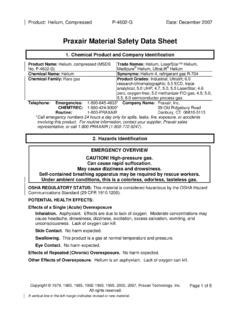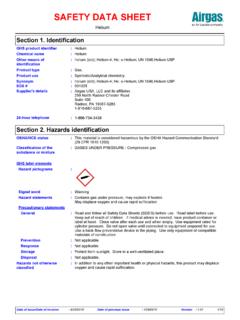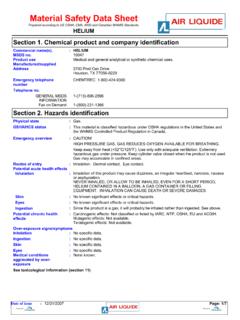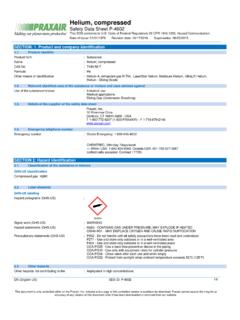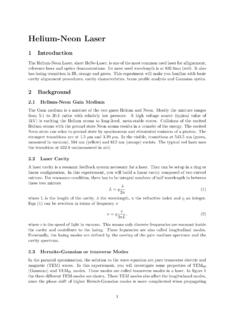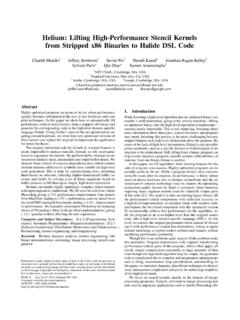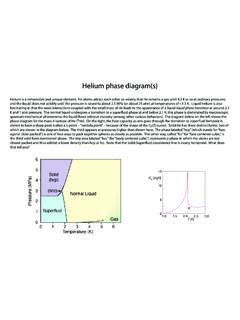Transcription of Geometric Models of Helium - arXiv
1 Geometric Models of HeliumM. F. Atiyah School of Mathematics, University of Edinburgh,James Clerk Maxwell Building,Peter Guthrie Tait Road, Edinburgh EH9 3FD, previous paper [13] modelled atoms and their isotopes by complex algebraicsurfaces, with the projective plane modelling Hydrogen. In this paper, Models ofthe stable isotopes Helium -4 and Helium -3 are : Helium -4, Helium -3, 4-Manifold, Elliptic Curve email: [ ] 8 Mar 20171 IntroductionFor some time, I and my collaborators, notably Nick Manton, have been developing theidea that all types of matter can be modelled by 4-manifold geometry [1]. Simple particles,like the electron and proton, are described by some of the simplest oriented these particles are electrically charged, the manifolds are non-compact.
2 Compos-ites, starting with the Hydrogen atom, are modelled by more complicated manifolds. Ifthe composite is electrically neutral, then the manifold is compact. Quantum numberslike baryon number and lepton number are related to the topological invariants of ideas are an extension of earlier ones. For example, the Kaluza-Klein monopole(at a fixed time) is a smooth 4-dimensional Riemannian manifold that is interpreted as aparticle in three dimensions [2, 3]. It is essentially the same as our model for one inspiration comes from Skyrmions [4]. Skyrmions are solitons in 3-dimensionalspace, modelling protons and neutrons [5], and larger nuclei [6], and it was shown in[7] that Skyrmions can, to a good approximation, be extracted from the holonomy ofYang Mills instantons in four 4-manifolds provide static, classical Models for matter.
3 Dynamics arises from thedynamically-varying moduli of the manifolds [8, 9]. Also, attempts to model quantummechanical features have been made [10, 11, 12]. Sections of suitable bundles over the4-manifolds can model quantum states, capturing their energies and spins.[13] proposed a dictionary which associated electrically neutral atoms to compact,complex algebraic surfaces [14, 15, 16]. The proton numberPof the atom is associatedwith the topological invariantP =14(e+ ) of the algebraic surface, whereeand are theEuler number and the signature. This invariant is always an integer for algebraic 1 we have Hydrogen and this is associated to the complex projective pflane wheree= 3 and = 1, so thatP = 1. From this meagre start it was remarkable how algebraicsurfaces with higher values ofP seemed to be sufficiently plentiful to associate to atomswith higher values the dictionary, isotopes with neutron numberNcorrespond to algebraic surfaceswith invariantN =14(e 3 ).
4 Thus Deuterium hasN= 1 and Tritium hasN= 2. Theassociated algebraic surfaces for ground states of these isotopes are obtained from theprojective plane by blowing up one point for Deuterium and two points for Tritium. Thelocation of the points blown up requires some symmetry breaking. The surfaces modellingthe ground states are related, but have different intersection forms. The geometry alsoseems to indicate, to some degree, the stability of certain isotopes, not just for Hydrogenbut also for higher proton numbers. [13] highlighted the case of Iron, where Iron-60 has1remarkable stability, in terms of its half-life. This is suggested by the geometrical modeland not adequately explained by conventional methods of nuclear Hydrogen, which accounts for 90% of the matter in the universe, the next mostabundant element is Helium , which accounts for a further 9%, leaving only 1% for allthe heavier elements.
5 The most common isotope is Helium -4, with Helium -3 far lessfrequent. These isotopes are stable and have many remarkable properties, depending ontemperature and Helium is particularly stable because its electrons form a closed shell, and theionization energy (the energy to remove one electron) is higher than for any other , the nucleus of Helium -4 is the alpha particle, a closed-shell (magic) nucleus. Thismeans among other things that the energy to remove one proton or one neutron from thenucleus is very large, more than twice the typical energy required in other stable the one hand these properties make Helium -4 a most useful element, for example incryogenics, but on the other, it poses severe tests for theoretical purpose of this paper is to describe in detail the algebraic surfaceMthat shouldbe associated to Helium -4.
6 As we will show, it is beautiful, subtle and unique, fullymatching the physical ,Mescaped attention in [13]. Crucially,Mis not simply-connected andits fundamental group is the quaternion group , of order 8. The first Betti number isthereforeb1= 0, but the first integer homology group is the abelianization of and sois the product of two cyclic groups of order 2. The universal coveringM ofMhas anaction of and the decomposition of the cohomologyH(M ,C) under this action gives bydefinition the cohomology ofMwith local coefficients. The group has four irreducible1-dimensional representations and one 2-dimensional one (see [17], Appendix).Mis also fibered over an elliptic curve with a projective line as fibre, and no exceptionalfibres.
7 For topological reasons, one might expect such a fibration to have a holomorphicsection. It does not, but the canonical line bundleKhas order 4, so it does have a 4-fold section, giving four distinct points on each fibre, whose cross-ratio is harmonic. Themonodromy action of the fundamental group permutes the six values of the here is so strong that it determines the model up to one overall scale factorkwhose square Models an energy level. The factorkitself depends on a choice of model is solvable in a strong sense, in that the partition function can be explicitly The notation indicates that the proton number is 2 ( Helium ) and that the atomic mass number(baryon number) is, respectively, 4 or 3, so the neutron number is 2 or down.
8 In fact it can be identified with a classical Theta function. The basic reasonfor this solvability is that an elliptic curve or torus is flat. We can also base ourselves onthe classical theory of Abel/Galois on the solution by radicals of quartic listed all the main properties of our algebraic surfaceMwe will, in section2, explain how to construct it and derive its properties. Sections 3 to 6 will explore itfurther. It is clear thatMis indeed a very special algebraic surface, as befits a model forthe very special atom Helium -4. Our conclusion is summarized in Section can ask what atom is modelled by the value of the modulus associated withhexagonal symmetry. It is hardly a surprise that the atom in question is Helium -3, butthis story is even more subtle, and deserves a whole section to itself, section ideas in [13] need much further development.
9 Proton numbersP= 1 (Hydrogen)andP= 2 ( Helium ) are, like rational and elliptic curves, rather special, whileP >2is the general case. This paper is therefore the transitional case, deserving particulartreatment. The analogy with the theory of algebraic curves is in fact fundamental as willbecome clear later in the The Algebraic SurfaceM(E)We will begin with a brief review of the classical theory of elliptic curvesEover thecomplex numbers. The salient points are (up to isomorphism):(i)Eis a 1-dimensional complex torus.(ii) Its fundamental group isZ Z.(iii) Its universal covering isC.(iv) Its modulus is, up to the action of SL(2,Z), a point in the complex upper-half plane.(v) The torsion subgroup, the symmetric group 3, has a fixed point of order 2 (thesquare lattice) and two fixed points of order 3 (the hexagonal lattice).
10 (vi) There are four spin structures onEcorresponding to the four points of period 2 onthe JacobianJ(E); 0 and the other three.(vii) At the spin level, the group SL(2,Z) is replaced by its double covering and thetorsion subgroup becomes the even part of the binary octahedral group, and hasorder 24.(viii) Points (iv)-(vii) relate to the solvability of quartic equations developed by Abel andGalois 200 years us denote byEnthe moduli space of divisor classes of degreenon the elliptic curveE. AllEnare isomorphic but not the elliptic curveEitself. Choosinga base point, called 0, turnsEinto an abelian groupE0, the JacobianJ(E). The space ofunordered point-pairs onEis the symmetric square ofEand we denote it by Sym2(E).
![arXiv:0706.3639v1 [cs.AI] 25 Jun 2007](/cache/preview/4/1/3/9/3/1/4/b/thumb-4139314b93ef86b7b4c2d05ebcc88e46.jpg)

![arXiv:1301.3781v3 [cs.CL] 7 Sep 2013](/cache/preview/4/d/5/0/4/3/4/0/thumb-4d504340120163c0bdf3f4678d8d217f.jpg)
![@google.com arXiv:1609.03499v2 [cs.SD] 19 Sep 2016](/cache/preview/c/3/4/9/4/6/9/b/thumb-c349469b499107d21e221f2ac908f8b2.jpg)







